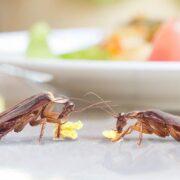Clay pigeons resemble an upside-down plate and are created from a blend of pitch and chalk meant to endure being fired through a clay pigeon pitfall at incredible velocities but also readily break when hit by just a couple of pellets shot with a shotgun.
What is the color of clay pigeons?
When made, the targets are black, but they can be any color you like to be visible against any background you choose.
What is the size and color of the clay pigeons?
The weight and size of clay pigeons are always the same since they are created to exacting standards.
It weighs 105 grams and is 110 mm in diameter, with a height of 25 millimeters, making it the most widely used target.
What are the Clay Pigeons made of?
Depending on the disc you choose, the composition of the clay pigeons varies. Petroleum pitch and calcium carbonate (limestone) are used in traditional clay pigeons.
Talc and petroleum resin are combined in an industrial mixer to create a paste for traditional clay birds. The material is then put into a molding machine, which molds the material as it cools.
Due to the large quantities of clay pigeons typically ordered by shooting ranges, they are placed on top of one another and formed into an elliptical pillar to make transportation and loading easier.
It does not matter whether your trap shooting or skeet shooting, you will always be using clay pigeons for the sport. In case you don’t know the difference between skeet shooting and trap shooting then I highly recommended reading a recent article by Justin Hook called Skeet Vs Trap Shooting. Justin went into great length trying to explain the difference and also included a lot of information regarding the sport. In fact I would ask you to bookmark the page for reference for future.
Are Clay Pigeons biodegradable?
Since the talc is biodegradable, it’s safe to use in traditional clay pigeons and doesn’t pollute the environment. Resin/pitch and paint, on the other hand, do not decompose. It’s possible that even if the particles aren’t visible, these compounds can harm animals because they never disintegrate. The minuscule clay pigeon fragments remain in the ground for all time.
It takes roughly two years for an ordinary clay pigeon to disintegrate 95 percent of the time. The disintegration procedure will speed up; just a biodegradable clay pigeon will entirely disintegrate.
How are biodegradable pigeons manufactured?
Biodegradable clay pigeons use the same manufacturing technique as conventional clay pigeons, except for biodegradable reactants. Rather than petroleum pitch, a natural resin is employed instead since it may be recycled by nature.
Biodegradable clay pigeons are the best clay pigeons, even if non-toxic ones uphold the manufacturer’s CSR. Natural materials are used to make them biodegradable and safe, and their footprint is limited. Biodegradable clay pigeons are often made with glucose, water, and birdseed as the primary ingredients. Grain can also be substituted for birdseed in some areas.
Which material is used in the manufacturing of biodegradable pigeons?
Biodegradable clay pigeons are made by several reputable companies, including Corsivia, White Flyer, & Champions BioBird, among others. Pitch-free and ISO 14021-compliant, the Corsivia Green Dream clay target claims to be. Like Champion BioBird Clay, White Flyer Bio Targeted, and Daisy Shatterblast, these products also claim to be 100% biodegradable. There are a wide variety of sizes and numbers of clay pigeons available from all of these reputable suppliers.
How Safe are Biodegradable Clay Pigeons?
Clay pigeons’ biodegradability is just a sign that the bio-target will inevitably be recovered by nature and would not leave an imprint like polythene bags. However, to assume that such clay pigeons are completely risk-free, then it would be mistaken. The pH of the soil can gradually be lowered by using these biodegradable clay pigeons, as previously stated. A rise in soil acidity could be disastrous for plants and grass, as it could harm their growth.
But it would necessitate modifying the shooting area and making a place for plants to thrive. While this isn’t the best concept, it would allow for a period during which a piece of land might be recovered by nature and put to use once more, allowing it to “cool off.”
Are Clay Pigeons Raising Environmentally safe?
The petroleum breaking method generates resin, often known as petroleum pitch or pitch. It serves as a bonding agent rather than a filler like chalk when used in production.
On the other hand, Biodegradable clay pigeons can be a problem for soil. Because they dissolve into the soil, they raise the soil’s acidity level. If no preventive action is done, this can harm plants and permanently alter the soil’s natural balance. Wildlife can choke on non-biodegradable clay pigeons,
Conclusion
In my opinion, the best way to replenish your supply is to use biodegradable clay pigeons. A step in the right way for me, as some recreational time fun should not harm the earth, we leave behind for future generations.













Comments